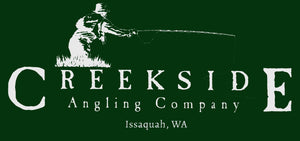
Winter Fishing report
Yakima River:
The Eastside of the Cascade mountains have settled into cooler temperatures, slowing trout fishing down and adjusting the fishes temperaments as well. While the numbers of fish being caught aren't staggering, we have had some reports of good to great streamer and nymph fishing on warmer days. While the fish may be more lethargic, they are still feeding, in order to prepare for the winter months. It may not be the numbers game you see in warmer months, so be thorough in the likely water to ensure fish are seeing your presentations! With the lower water flows and temperatures, the trout will increasingly inhabit slower, deeper sections of the river. With the cold weather, dry fly fishing will be quite limited to sparse BWO hatches from 1-3 pm on cloudy days. Otherwise it will be a subsurface game, with nymphs entailing Stoneflies #6-10, BWO's #18-20 (the fall hatch tends to be smaller sizes!), midges #16-20, and San Juan worms, especially if there has been recent rainfall. The trout have been quite sensitive when taking flies under an indicator, attentiveness is required to ensure you hook fish that eat your flies while nymphing! There are typically larger fish that can be targeted with streamers as well, though large, gaudy flies are not warranted. Smaller Sculpins, baitfish, and Woolley Buggers can entice these nice fish looking for a larger meal.
While it can be brutal east of the Cascades in winter, spontaneously finding a warmer day to fish the Yakima can reward you with good trout fishing!
Snoqualmie Forks:
The Snoqualmie Forks have been in better shape lately with the lack of rainfall over the past week, though the water temperatures have steadily decreased as well. You can fish streamers/nymphs to some success this time of year, though the cold water leads to lethargic trout that tend to wane feeding. Typically we tend to cease fishing on the forks through winter months due to the much cooler water and picky trout, though if you care to venture to the Middle or South Fork you can still find fish. Nymphing smaller stonefly patterns with a BWO or midge trailing should attract trout and provide the most success. Otherwise smaller sculpins and Wooley Buggers can be fished on a tight line in deeper pools and runs as well!
Lakes:
Many lowland lakes are beginning to slow productivity, though there remains opportunity to catch trout for those willing embrace the cool and wet weather. Some local lakes such as Beaver and Rattlesnake have been producing trout trolling or retrieving leeches and buggers! Fishing chironomids/leeches under an indicator are techniques to consider as well. Pass Lake is another option during the fall/winter months as well! If the lake houses Brown trout, don't be afraid to employ baitfish flies as these species of trout tend to be more carnivorous.
Eastside lakes are still options to find fish until we see the begin to freeze over. Employing the same techniques as listed above should be enough to catch trout on these lakes.
Alpine lakes are now out of the picture now as snow has begun piling up at higher elevations. Unless you plan on ice fishing in avalanche terrain, its best to stick to lowland lakes until next Summer.
Saltwater:
The Puget Sound has been fishing ok to good for Cutthroat trout. While winter may seem bleak and dreary on the Sound, it can provide one of the more consistent trout fisheries comparative to rivers and lakes. Many Cutthroat will co-mingle with the Salmonids as they spawn in the freshwater, though many do remain in the saltwater as well. While the fish will generally be around creek and river estuaries, many beaches with sufficient habitat in the North and South Sound will harbor fish, so don't be too picky which one you land on. Besides finding structure such as rocks, oyster beds, and points, ensure you are on the lookout for moving water when fishing the sound, which will be present during moving tides. Most importantly, if the current beach is devoid of life change your location to another local beach. Some of our favorite flies are smaller baitfish patterns such as Clouser Minnows, otherwise Euphasiid's, Sand Eel's and Sculpins are all good flies to tie on and cast to the cruising Cutties!
Steelhead:
Eastside Steelhead fishing was good to great this Fall on some of the Columbia River tributaries. From the Grande Ronde and Klickitat, to the first opening on the Methow we had seen in ten years, there was plenty of opportunity to chase after these fabled fish! With December upon us, it is time to transition to Puget Sound and Coastal returns of Steelhead. We have begun to see fish arrive at local hatcheries such as Tokul Creek on the Snoqualmie and Reiter Ponds on the Skykomish, though numbers have only begun to trickle in. The Skagit will remain open through January at minimum, with a fishery to be announced past January 31st later this winter. If you haven't seen the upcoming coastal river season implementation by WDFW, it is promising in contrast to the last few years. Steelhead numbers are forecast to increase from prior runs, allowing the opening of more river systems for catch and release fisheries. You can find those regulations here: https://wdfw.wa.gov/newsroom/news-release/wdfw-announces-2024-25-coastal-steelhead-regulations. Whether bobber fishing or swinging flies, the time is now to get prepared for the winter Steelhead season upon us!




